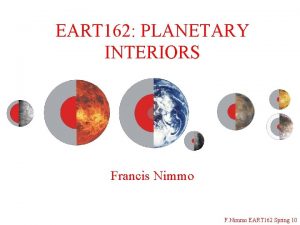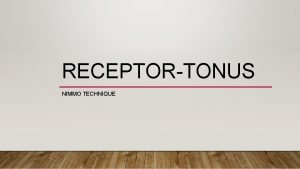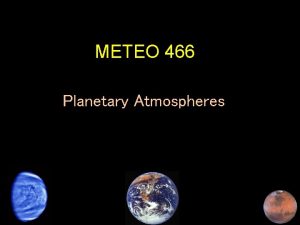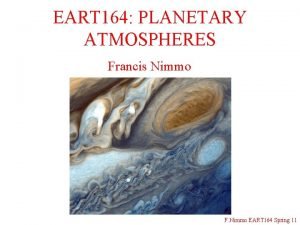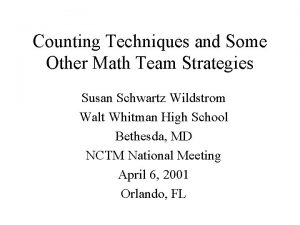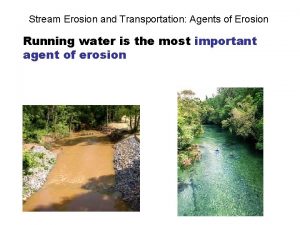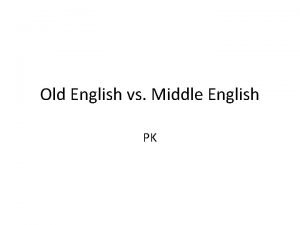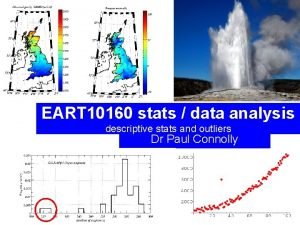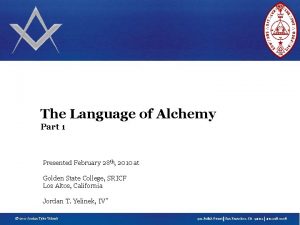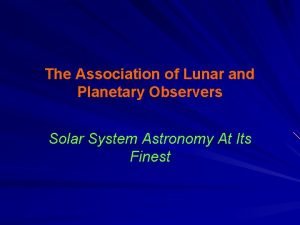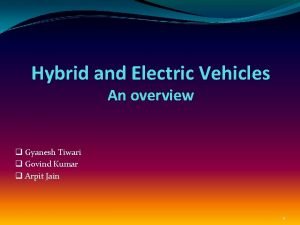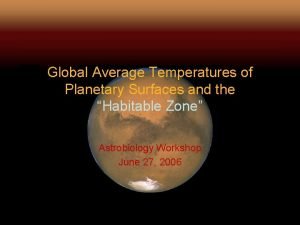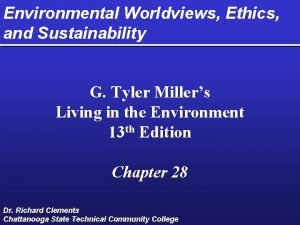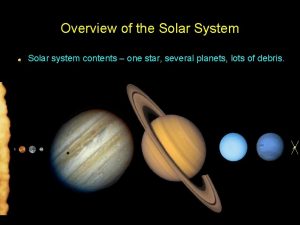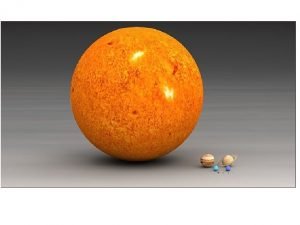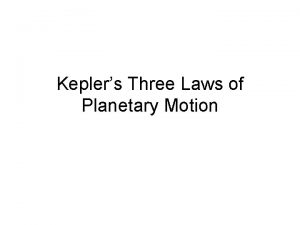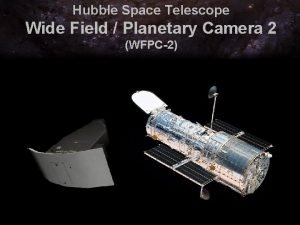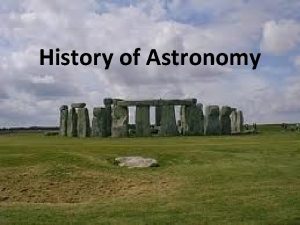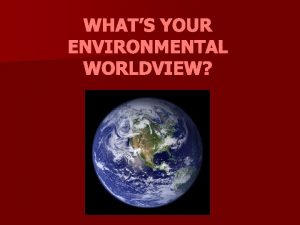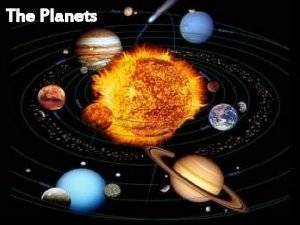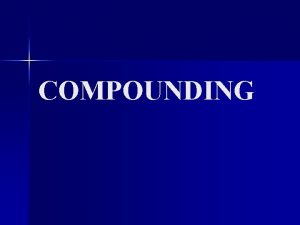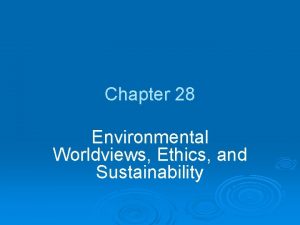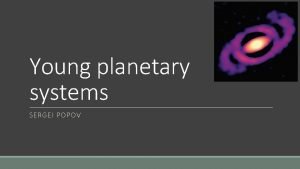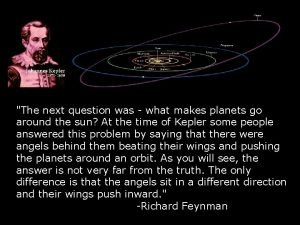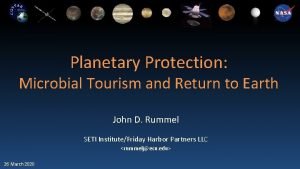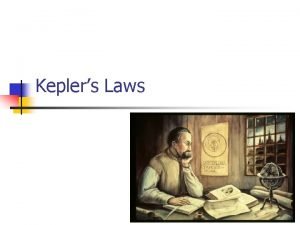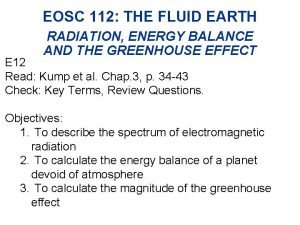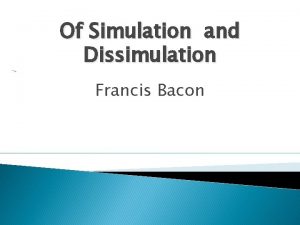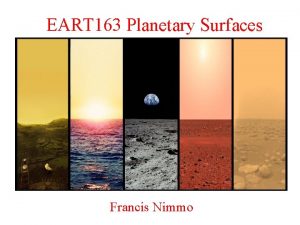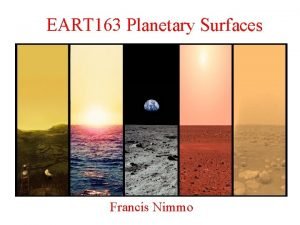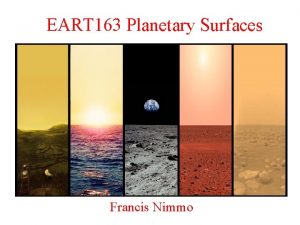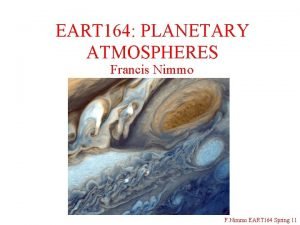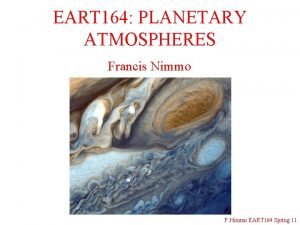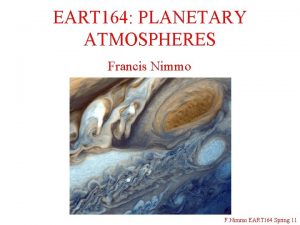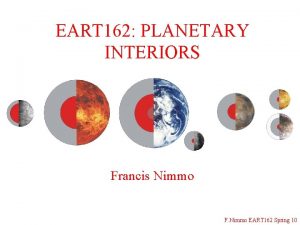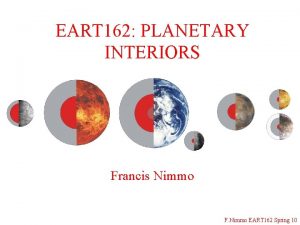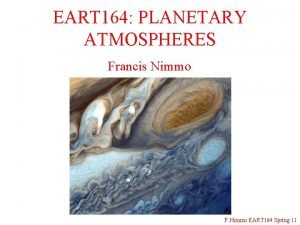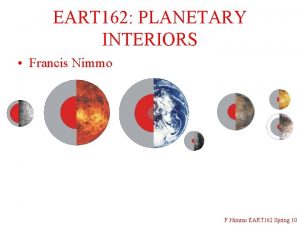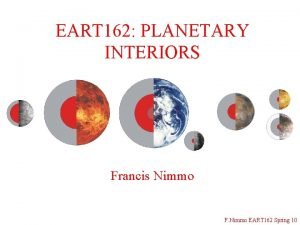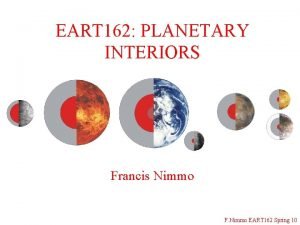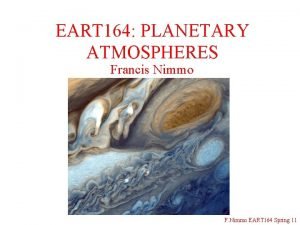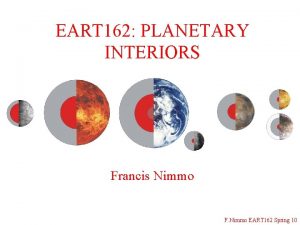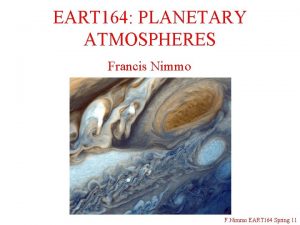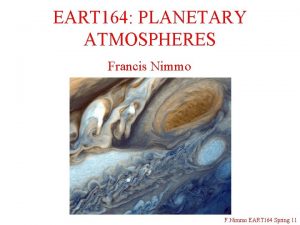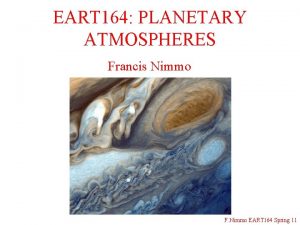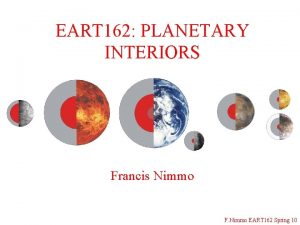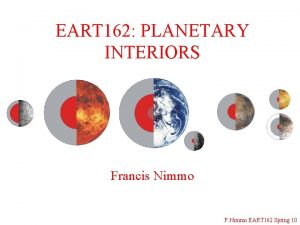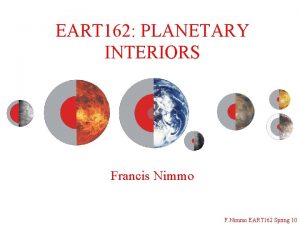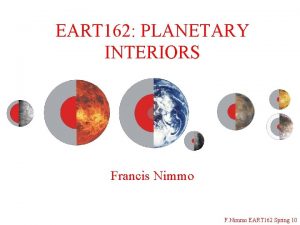EART 163 Planetary Surfaces Francis Nimmo Summary Wind




































- Slides: 36

EART 163 Planetary Surfaces Francis Nimmo

Summary - Wind • Sediment transport – Initiation of motion – friction velocity v*, threshold grain size dt, turbulence and viscosity – Sinking - terminal velocity – Motion of sand-grains – saltation, sand flux, dune motion • Aeolian landforms and what they tell us

This Week – Ice & Sublimation • • Ice rheology Glaciers & ice sheets Ice in the subsurface Sublimation

Glaciers • Ice accumulates in high regions (lapse rate) • Flows downhill once sufficiently thick (velocity strongly depends on h) • Loss by melting and/or sublimation at low elevations

Non-Newtonian Flow Vertical distance z • Ice is non-Newtonian – strain rate depends on (stress)n • This alters the flow behaviour Newtonian (n=1; parabolic) a Non-Newtonian (n>1) Velocity u Axisymmetric, flat flow 2 D, downslope flow h r Replace a with h/r flow h

Ice rheologies Tref (K) A (MPa-n s-1) n Q (k. J/mol) Water ice 270 10 -6 1. 8 50 CO 2 170 1. 5 x 10 -6 4. 5 30 N 2 50 2 x 10 -2 2. 2 5 • All three are non-Newtonian (n>1) • At the same temperature, the viscosity order is N 2 << CO 2 << H 2 O • In reality, rheology also depends on grain size, silicate fraction etc.

Rock Glaciers • • Rare on Earth Rock particles increase viscosity Common(? ) on Mars On Mars, ice may have sublimed away – see later Alps, Earth Mars

Nitrogen Glaciers on Pluto

Solid nitrogen rheology Yamashita et al. 2010 Not easy experiments to do! Suggest solid N 2 is very soft (~108 Pa s at 45 K) compared to ice (~1013 Pa s at 270 K)

Cold vs Warm-based glaciers Vertical distance z • On Earth, the base of a glacier can be either above the freezing point (“warm”) or below it (“cold”) • Cold-based glaciers have ~zero velocity at the base • Warm-based glaciers have non-zero basal velocities (liquid water and/or soft sediments lubricate the base) • Warm-based glaciers can undergo “surges” when the basal conditions change (e. g. water is rerouted) Cold-based Warmbased Velocity u • Ice-sheets (e. g. Antarctica) are subject to feed-backs e. g. more melting -> more lubrication -> faster flow -> more ice loss etc. . . • The ocean can also play a role in this case (seawater infiltration)

Glacial erosion Cross-section h Glacial erosion happens mainly via embedded rocks Rate of erosion depends on overburden pressure (rgh) But if the overburden pressure exceeds ~3 MPa, the erosion shuts off – because the rocks get pushed upwards into the ice (the ice yield strength is exceeded) This explains why glaciation produces U-shaped valleys (why? )

Glacial Deposition • Glaciers leave a variety of deposits as they retreat • Analogues to some of these deposits have been identified on Mars Eskers on Mars?

Glaciation on Mars Lobate debris aprons (LDAs)

Ice sheet profiles (static) Net force = rgh 2/2 L Ice sheet h Net resistance= YBL a

Martian polar caps • Water ice below CO 2 • Polar troughs – wind? • Radar sounding

Are the Martian caps CO 2 ice? CO 2 Tref (K) A (MPa-n s-1) n Q (k. J/mol) 170 1. 5 x 10 -6 4. 5 30 Martian ice cap, 160 K h= 2 km, r=300 km, g=3. 7 ms-2, r=1. 5 g/cc At 160 K, A=0. 4 x 10 -6 MPa-n s-1 rgh=11. 8 MPa, umax=0. 05 m/yr Flow timescale ~ r/umax ~ 6 Myr Doesn’t seem completely implausible, but what about the canyons? h= 1 km, r=50 km umax=0. 1 m/yr Flow timescale ~ 0. 5 Myr Seems very short!

Radar Sounding • Propagation speed identifies material (water ice) • Layering suggests climate cycles (e. g. Milankovich) • But we don’t have good absolute ages

Ice wedges & Polygons • Formed by melting-freezing cycles • Near-surface features – annual thermal wave penetrates a depth ~ (kt)1/2 • Scale of polygons not well understood

Mars Polygons Patches of ice just below the surface, revealed by Phoenix thrusters

Ice exposed at the surface Mars Express image 70. 5 o North, 35 km across Hi. Rise image ~70 o North, 50 m across

Neutron Spectrometer • Cosmic rays produce neutrons • Neutrons can be detected from orbit • Hydrogen is a good absorber of neutrons • A lack of neutrons implies near-surface (<2 m deep) hydrogen • This is assumed to be water ice

Sublimation vrms vapour rg solid rs • In equilibrium, a solid (or liquid) will have a finite vapour pressure above it • At this vapour pressure the upwards and downwards molecule fluxes are equal • The downwards flux ~ rg vrms If the vapour is removed, the upwards flux will exceed the downwards flux and sublimation will result The rate of solid removal dh/dt is given by: a

Energy limitations • Vapour pressure is strongly temperature-dependent • So sublimation depends on temperature • Sublimation also takes energy (because conversion to vapour requires latent heat L) • Maximum sublimation rate is limited by available power per unit area F: • Sublimation rate also decreases if the pressure above the solid surface is non-zero

Example Vapour Pressure Curve Water/Ice (pressure in Pa, T in K)

Where does sublimation happen?

Sublimation of Water Ice Temp (K) Pvap (Pa) dh/dt (m/s) t (1 km loss) 120 4 x 10 -10 7 x 10 -16 45 Gyr 150 6 x 10 -6 1 x 10 -11 3 Myr 180 4 x 10 -3 6 x 10 -9 5 kyr 220 1 1 x 10 -6 30 yr Phoenix landing site • • Applications: Galilean satellites Ceres Mars Occator crater, Ceres

Sublimation Features (? ) “Bladed terrain” on Pluto (spacing ~5 km) “Spires” on Callisto “Penitentes” on Earth

“Swiss cheese terrain”, Mars ~1 m per year recession Martian polar winter 100 m scalebar (appx)

“Spiders” on Mars? “Spiders” are typically ~200 m across Similar process on Triton?

Lag deposits • Albedo-sublimation feedbacks occur • Sublimation shuts off once a thick enough lag deposit is produced (few metres) • Relevant to Mars and bodies in the outer solar system Spencer (1987)

Iapetus • Extreme albedo contrasts • Albedo-sublimation feedbacks • Combination of dust deposition and volatile trapping Spencer & Denk (2010)

Summary – Ice & Sublimation • Ice rheology – Non-Newtonian • Glaciers & ice sheets – Cold-based vs. warm-based – Erosional & depositional features • Ice in the subsurface – Polygons, ice wedges, thermal wave, neutron data • Sublimation – Albedo-lag feedbacks

Next Steps • Next Tuesday (4 th) – Fluvial; PS#7 due • Next Thursday (6 th) – recap/revision • Final – Weds (12 th) 12 pm-3 pm

Polygons & Patterned Ground

flow h z

Radar Sounding • Propagation speed identifies material (water ice) • Layering suggests climate cycles (e. g. Milankovich) • But we don’t have good absolute ages Milankovitch cycle image? Mars single seismometer? Ocean tsu
 Francis nimmo
Francis nimmo Types of art therapy
Types of art therapy Ray nimmo
Ray nimmo Googlegoole
Googlegoole Meteo eart
Meteo eart Eart
Eart Googol eart
Googol eart Fæder ure þu þe eart on heofonum
Fæder ure þu þe eart on heofonum What is erosion
What is erosion Old english vs middle english examples
Old english vs middle english examples Eart meaning
Eart meaning Wind von backbord weicht wind von steuerbord
Wind von backbord weicht wind von steuerbord Alchemical language
Alchemical language Association of lunar and planetary observers
Association of lunar and planetary observers Prius planetary gear animation
Prius planetary gear animation Planetary temperature calculator
Planetary temperature calculator Earth centered worldview
Earth centered worldview Planetary systems
Planetary systems Planetary systems
Planetary systems Planetary positions today
Planetary positions today Kepler's three laws of planetary motion
Kepler's three laws of planetary motion Planetary data analysis
Planetary data analysis Wide field and planetary camera 2
Wide field and planetary camera 2 Stonehenge planetary orbits
Stonehenge planetary orbits Which factor causes global wind patterns?
Which factor causes global wind patterns? Planetary management worldview definition
Planetary management worldview definition Law of planetary motion
Law of planetary motion Planetary mixer definition
Planetary mixer definition Environmental worldviews, ethics, and sustainability
Environmental worldviews, ethics, and sustainability Planetary model
Planetary model Brown dwarf
Brown dwarf Kepler's first law equation
Kepler's first law equation Planetary protection
Planetary protection Nasa planetary science
Nasa planetary science Kepler's law of planetary motion
Kepler's law of planetary motion Eosc 112
Eosc 112 Francis bacon of simulation and dissimulation
Francis bacon of simulation and dissimulation
